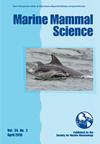Overwintering humpback whales adapt foraging strategies to shallow water environments at the mouth of the Chesapeake Bay, Virginia, USA
IF 2
3区 生物学
Q2 MARINE & FRESHWATER BIOLOGY
引用次数: 0
Abstract
Some humpback whales from the Northwestern Atlantic population forgo migration to the Caribbean, spending winter months feeding along the U.S. mid‐Atlantic coast. We studied the foraging behavior of these whales at the mouth of the Chesapeake Bay, Virginia during winter from 2017 to 2022. While shipping channels here reach depths of up to 30 m, most of the area is 11–15 m deep. This shallow‐water environment poses physical constraints on classical humpback whale feeding modes. We deployed 20 digital acoustic tags (DTAGs) on humpback whales and identified foraging lunges from accelerometer data, detecting 788 lunges from 10 animals. Tagged whales averaged a single lunge per dive, lunging primarily in a horizontal orientation, with limited maneuvering compared to other study sites. Our results indicate that some elements of humpback whale foraging behavior are conserved across environments, but that the shallow depths in our study area constrain how animals are able to feed. The relatively high lunge rates we observed suggest this area is an important foraging ground. However, foraging in shipping channels increases the risk of ship strikes, which frequently occur in this area.越冬座头鲸适应美国弗吉尼亚州切萨皮克湾口浅水环境的觅食策略
西北大西洋种群中的一些座头鲸放弃了向加勒比海的迁徙,而是在美国大西洋中部海岸觅食过冬。我们研究了这些鲸鱼 2017 年至 2022 年冬季在弗吉尼亚切萨皮克湾口的觅食行为。虽然这里的航道水深可达 30 米,但大部分区域的水深为 11-15 米。这种浅水环境对座头鲸的经典觅食模式造成了物理限制。我们在座头鲸身上部署了 20 个数字声学标签 (DTAG),并通过加速度计数据识别觅食跳跃,共检测到 10 头鲸的 788 次跳跃。与其他研究地点相比,被标记的鲸鱼平均每次潜水只进行一次跳跃,主要以水平方向跳跃,机动性有限。我们的研究结果表明,座头鲸觅食行为的某些要素在不同环境下是一致的,但我们研究区域的浅水限制了鲸鱼的觅食方式。我们观察到的相对较高的跳跃率表明,该区域是一个重要的觅食地。不过,在航道上觅食会增加船只撞击的风险,而这一地区经常发生船只撞击事件。
本文章由计算机程序翻译,如有差异,请以英文原文为准。
求助全文
约1分钟内获得全文
求助全文
来源期刊

Marine Mammal Science
生物-动物学
CiteScore
4.80
自引率
8.70%
发文量
89
审稿时长
6-12 weeks
期刊介绍:
Published for the Society for Marine Mammalogy, Marine Mammal Science is a source of significant new findings on marine mammals resulting from original research on their form and function, evolution, systematics, physiology, biochemistry, behavior, population biology, life history, genetics, ecology and conservation. The journal features both original and review articles, notes, opinions and letters. It serves as a vital resource for anyone studying marine mammals.
 求助内容:
求助内容: 应助结果提醒方式:
应助结果提醒方式:


